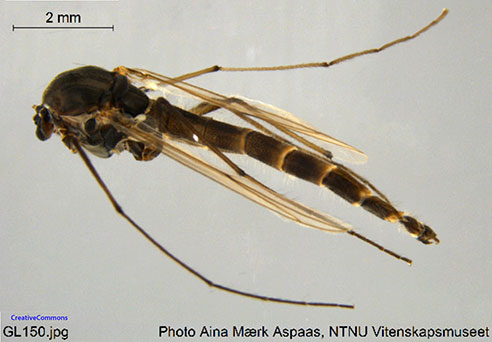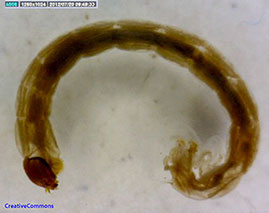Some characters of the adult males can be determined from photographs in the BOLD Database:
Male: Color dark blackish-brown, halteres pale; abdomen with a thin pale stripe at the posterior margin of segments II-VII; legs apparently paler, knees slightly darkened.

Adult male of C. sp.8TE from Greenland (BOLD Database)
AR about 3.
Wing length about 5.38-5.43 mm, width about 1.1 mm, VR about 1.0.
Palps pale, segment lengths (segs. 2-5) (micron) 114 : 400 : 315 : 485.
Legs with a weak beard. Approximate proportions (micron):
|
Fe
|
Ti
|
Ta1
|
Ta2
|
Ta3
|
Ta4
|
Ta5
|
LR
|
F/T
|
BR
|
PI
|
1665
|
1765
|
2600
|
1170
|
750
|
645
|
265
|
1.48
|
1.07
|
low
|
PII
|
1715
|
1590
|
950
|
570
|
540
|
490
|
280
|
0.65-0.70
|
1.05
|
|
PIII
|
2140
|
2460
|
1715
|
945
|
600
|
490
|
245
|
0.65-0.70
|
abt 0.8
|
|
Pupa: Not known.
Fourth instar larva: The larva is probably a thummi-type larva, as no plumosus-type larva is currently known from Greenland.

Larva of C. sp. 8TE from Manitoba, Canada (BOLD database)
Larval head capsule is relatively dark, with gula darker. Presence of LP could not be determined (but see above); VT long, and posterior pair coiled. Anal tubules appear to be relatively long and possibly with a constriction in the middle.
Cytology: Unknown.
Molecular sequence:
mtCOI: There is sequence in the BOLD Database.
Found: Manitoba - nr. Churchill (58.738°N, 93.819°W) (BOLD).
Yukon Territory - (BOLD).
Greenland - Lake Tasersuaq, Kitaa, Kujalleq (60.2643°N 44.5389°W); Narsarsuaq, Kujalleq (61.1556°N, 45.3785°W) (both BOLD).
[ Return to Index
| Go to References ]

